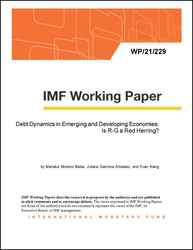
Debt Dynamics in Emerging and Developing Economies: Is R-G a Red Herring?
Debt Dynamics in Emerging and Developing Economies: Is R-G a Red Herring?
READ MORE...
Volume/Issue:
Volume 2021
Issue 229
Publication date: September 2021
ISBN: 9781513596259
$5.00
Add to Cart by clicking price of the language and format you'd like to purchase
Available Languages and Formats
| English |
Prices in red indicate formats that are not yet available but are forthcoming.
Topics covered in this book
This title contains information about the following subjects.
Click on a subject if you would like to see other titles with the same subjects.
Banks and Banking , Exports and Imports , Economics- Macroeconomics , Public Finance , Economics / General , dampening debt , interest-growth differential , debt build-up , debt-stabilizing role , debt Decomposition , Debt sustainability analysis , Real interest rates , Contingent liabilities , Global
Summary
In the wake of the COVID-19 pandemic, debt levels in emerging and developing economies have surged raising concerns about fiscal sustainability. Historically, negative interest-growth differentials in these countries have played a debt-stabilizing role. But is this enough to prevent countries from falling into debt distress? Drawing from a sample of 150 emerging and developing economies going back to the 1970s, we find that interest-growth differentials have remained relatively low, dampening debt increases in the run up to a crisis. But in the face of persistent primary deficits, debt service tends to rise abruptly—particularly in emerging markets—and a fiscal crisis ensues. There is also evidence that a large part of the debt build-up around crises stems from valuation effects associated with external debt and the materialization of contingent liabilities. These findings underscore that, though not necessarily a red-herring, low interest-growth differentials cannot fully offset the deleterious effects of large fiscal deficits, forex exposures, or hidden debts.
Copyright © 2010 - 2025
Powered by:
AIDC



